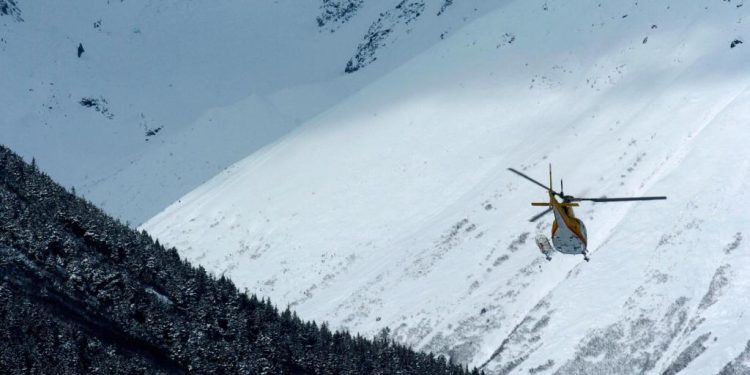By Mark Thiessen and Becky Bohrer
Girdwood, Alaska (AP) – The Alaska authorities said they would try Thursday to reach the site of an avalanche that trapped three skiers, who would have died after being buried in the snow.
The bad weather prevented soldiers from the State of Alaska, avalanche experts and recovery teams to reach the slide near Girdwood, about 40 miles south of Anchorage on Wednesday, said the spokesman for Austin McDaniel.
“We are optimistic that we will be able to carry out an air assessment today for avalanches safety considerations and determine the possible recovery options,” McDaniel told an e-mail on Thursday at the Associated Press. “The site is only accessible to the air.”
The avalanche occurred Tuesday afternoon after a helicopter delivered skiers to a top-shaped top in the Chugach mountains. Three skiers were captured in the avalanche and estimated at more than 30 feet of snow.
What happened?
Heli-ski customers and guides were on a mountain about 8 miles northeast of Girdwood airport when the avalanche started. The avalanche seemed to have started at around 3,500 feet and rested at around 700 feet, said Tracey Kutson, spokesperson for Chugach Powder Guides, who knew the trip.
Helicopters use helicopters to reach mountains in remote living room areas where there are no ski ups. They then ski or the snowboard.
While the slide began, witnesses saw the men deploy their inflatable avalanche cushions – inflatable vests intended to keep the victims of avalanche above or near the surface, said Knutson.
The snow deposited by the avalanche was up to 100 feet deep, soldiers said. Skiers were probably buried at depths greater than 30 feet, said Knutson.
“Three guides on the premises immediately published an rescue alert and initiated the rescue response,” Kutson said in a statement. While more guides of the region’s helicopters have arrived to help, they picked up signals from the emergency tags for the victims, but decided that there were not enough resources on site to recover them safely on Tuesday, Kutson said.
The victims were customers outside the state who were on the side with a guide on a road that is used regularly by the company, said Kutson,
Who were the victims?
The Troopers of the State of Alaska published Thursday the identity of the three missing men caught in the slide: Dave Linder, 39, of Florida; Charles Eppard, 39, from Montana, and Jeremy Leif, 38, from Minnesota.

The Subarctic Media, which have radio stations across Minnesota, said that Linder, of Miami, was one of its owners.
General partner Matt Ketelsen said Linder was on vacation with friends to ski cross -country in Alaska. Ketelsen said he had no details on the avalanche.
“Dave was a big skier, a good very confident skier,” said Ketelsen. “He had already done this before. It was not new to him.
Ketelsen described his trading partner as a devoted father of three young boys.
“He loved communities that his companies and our radio stations served,” said Ketelsen.
“And it’s a sad day here when you lose someone who is really passionate about the company in which he is.”
Eppard, who went by Charlie, grew up in Mankato, Minnesota, said his brother Jon to the Associated Press.
“As small children, I don’t remember exactly the age it started, but I always wanted to be like my big brother,” said Jon. “And he was great in skiing, so it made me ski because I wanted to be like him.”
Charlie was only a few weeks old from his 40th birthday, Jon was two years younger. The two brothers settled in the west, Charlie in Montana and Jon in Anchorage.
“And skiing has always been part of it,” said Jon. “I think he was really delighted when I ended up moving to Alaska.
Even if the brothers had not spoken for a while, they registered themselves and would speak of their shared ski passion.
“It was certainly the thing we have connected the most,” said Jon.
Charlies and his wife, Brittany Mitchell, have a daughter, Belen. He worked remotely in software sales for IBM, which allowed them to continue the lifestyle they wanted in the West.
“He was a super passionate guy and everything he did, he was like everything that is,” said Jon. “I just feel lucky to have him as a big brother.”
Attempts to reach Leif family members have not succeeded.
What caused the slide?
Experts did not want to speculate on Tuesday’s avalanche until they had the chance to inspect the site.
However, an acre concern in progress for the region was a small layer of snow that was buried up to 2 feet or more below the surface, said Andrew Schauer, avalanche forecuingist of the Chugach with the Chugach Forest Avalanche Information Center.
The center forecasts for Tuesday for the Girdwood region have listed the danger of the avalanche at high altitudes as “considerable”.
No more snow and wind Wednesday added weight “and made the avalanches a little larger and more likely,” said Schauer. The conditions were expected to remain dangerous even after the success of the storm system.
Where did the avalanche occur?
The area where the slide has occurred is the epicenter of skiing in Alaska.
Girdwood is a tourist community for winter events, with skiing and snowboarding downhill at Alyeska station in a spectacularly picturesque place. After a gondola tour, 3,200 feet (975 meters) at the top of Mount Alyeska, the guests can see seven glaciers from the restaurant named for this view.
But there are many other tourism and guidance companies that offer visits to sled dogs, climbing, ice skate, snowmobiles and helicopter trips and glacier excursions.
Bohrer contributed by Juneau, in Alaska. The journalist of Associated Press Jennifer Kelleher contributed to Honolulu.
Originally published:
California Daily Newspapers









